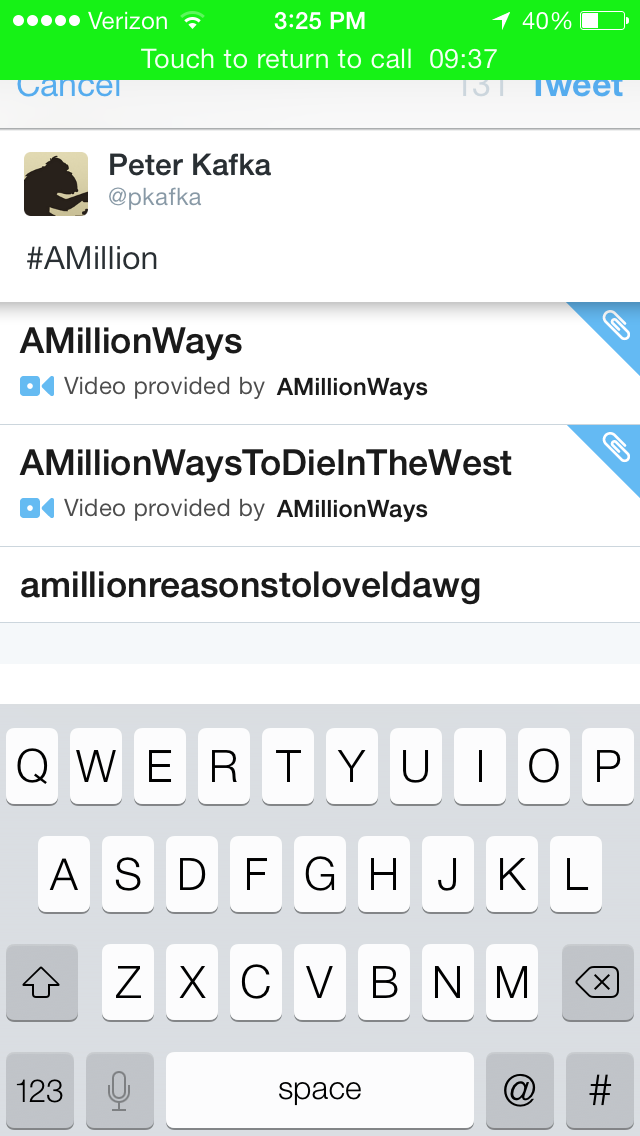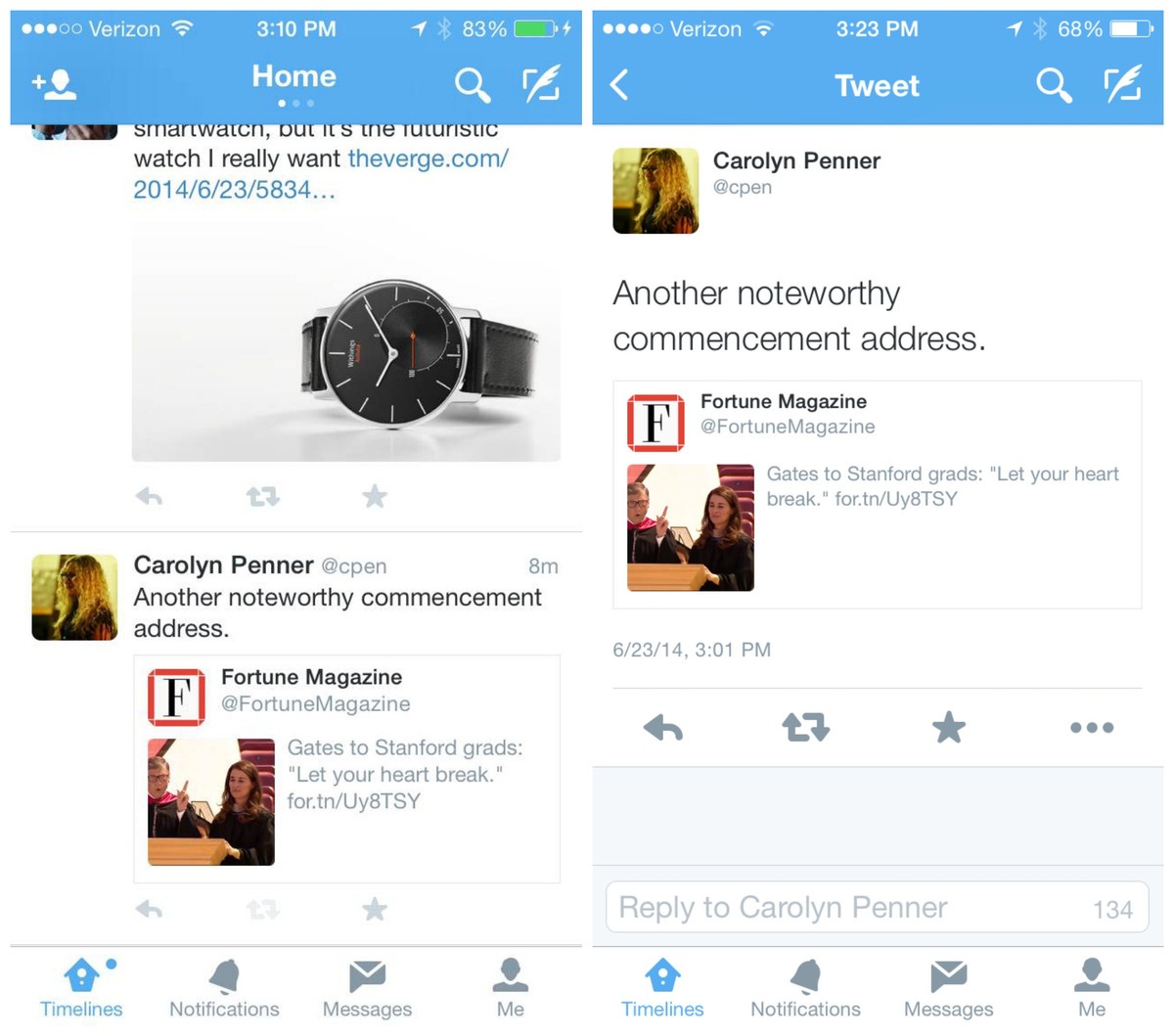If you ask someone who works at Twitter about the company’s experiments, you won’t get an answer. Company policy is no comment. That doesn’t mean that there aren’t plenty of novel updates and strange new features brewing in San Francisco. You might have taken part in Twitter’s tests without even realising it.
Twitter, like most companies, will often discreetly change parts of its services and turn batches of users into test subjects for new designs and features. Users report strange interface changes and unexpected feature updates. Sometimes, those trials graduate into full-fledged features, like the recently introduced “mute” button. More often, nothing materialises on a wider scale. Some of the experiments are awful: If view counts on tweets ever become a thing, I am boycotting. Others, I’d like to see expanded.
This kind of testing is common for any company, but when it happens on as large a stage as Twitter they garner extra attention — and have potentially much broader impact. Here are some recent experiments that we’d like to see turn into everyday features.
Favourites for User Profiles
Last December, Twitter tested a feature where Android users could “favourite” entire accounts, in addition to individual tweets. So instead of faving a Rob Delaney tweet, someone could fav Rob Delaney’s entire account. The actual test feature was annoying, because Twitter sent push notifications whenever someone whose account you faved tweeted. That’s way too many push notifications, and it would have killed the feature had they taken it wide.
Drew Olanoff tested the feature when it was available:
Fav’ing accounts on twitter? Hmmm pic.twitter.com/SLOkziMYZw
— drew olanoff (@drew) December 24, 2013
But the basic idea of favoriting users is smart, and could help fix Twitter’s list feature. Twitter’s list function should be one of the company’s most valued tools, a way to help users enjoy multiple experiences of a Twitter stream. But Twitter treats its “Lists” feature like a basement baby, shuttling it into the “More” section of user profile pages. The Lists feature is unfairly ignored, and should have a far more prominent position. Introducing a way to favourite users would be a smart approach to easing people into the idea of organising their Twitter experience into smaller feeds by giving them a feed of just favourites. Make this happen!
Achievements
Do you want to know how many people engage with your Twitter account? Right now, Twitter users desperate to see how many RTs they stack up week by week have to consult third party apps. This is the bane of brand managers, narcissists, and brand-managing narcissists everywhere, and Twitter introduced what could be a simple fix as an experiment this past January: The @AchievementBird account gave users updates about how popular they are on Twitter, sending DMs with stats about RTs and new followers.
The account appears to be inactive now, so it won’t accept your follow request. The Next Web’s Owen Williams tweeted an example of what it looks like to get an update:
Twitter achievements experiment is neat https://t.co/9GDosj1w2L
— Owen Williams (@ow) January 8, 2014
It’s too bad that Twitter hasn’t taken this one wider; it lets people opt into knowing more about their engagement status without bothering with push notifications or alienating users who really don’t give a shit if their recent tweet performed five times better than their average tweets. Achievements didn’t get as much attention as Twitter’s experimental breaking news account EventParrot, but it was the superior experimental DM-based account, since EventParrot never really figured out which news was relevant.
Setting Links Free
In May, Recode’s Peter Kafka discovered a Twitter experiment that could open up a whole new use case for hashtags. It played with the idea of having certain hashtags prompt an embedded video to appear, using Seth MacFarlane’s A Million Ways To Die In The West as an example. When certain users started typing #AMillionWaysToDieInTheWest as a hashtag, Twitter offered the option to embed a clip from the film. Twitter continued this experiment during the World Cup with Adidas and Visa.

Picture: Peter Kafka, Recode
The specifics of the experiment were obviously, irrefutably terrible. A Million Ways To Die In The West looks like a turd. And who, really, wants to insert an ad into their tweets? If Twitter only allows brands to select which hashtags link up to videos, this feature could be immensely infuriating.
But if Twitter gives the hashtag embedding feature to individual users as well as brands, turning a hashtag into a linking agent could improve the overall user experience, especially for people who like to share links. And why stop at hashtags? Twitter should give users the ability to embed or hyperlink to other URLs and media instead of letting them choke up your character limit.
There’s really no reason to include links in the 140-character count, and we shouldn’t have to resort to bit.ly to trim down even further than Twitter’s native link-shortening allows. Photos and videos are already exempt; links should be too. This experiment proves that Twitter has the capacity to let users turn parts of their tweets into hyperlinks, and it should.
If Twitter only expands this feature to allow brands to link to ads via hashtags, it will be a sad example of privileging business interests at the expense of the regular user.
Retweet With Comment

Picture: Mashable
Twitter’s most recent publicised experiment would be a kickass addition to its feature roster. A “Retweet With Comment” option appeared as a test to some users in late June, allowing people more space to comment on stuff they RT. The feature turned the RT into an image, which gave the retweeter way more room to add their own thoughts. Like the linked hashtags, this feature helps maximise the amount of space someone has to say what they want to say.
Retweet With Comment is my favourite recent experiment because it more or less fixes what is broken about retweeting: That retweeting a longer tweet gives users no room to add their own take. This feature would make people want to retweet each other more frequently, since it’d be easier to throw on a pithy joke or observation. It’d be a smart engagement tool to promote.
Twitter’s experiments can be duds, and its constant tinkering does make the company seem a little lost and unfocused. But the beauty of its frequent testing and evaluation is that experiments like these can eventually evolve into beloved features.
Twitter went from San Francisco start-up to international water cooler in just a few years, and it’s easy to forget that the service is still a work in progress. These experiments prove that it’s still a platform ready and willing to make big changes — even if most of them start out as secrets.
Picture: Shutterstock/Pressmaster
